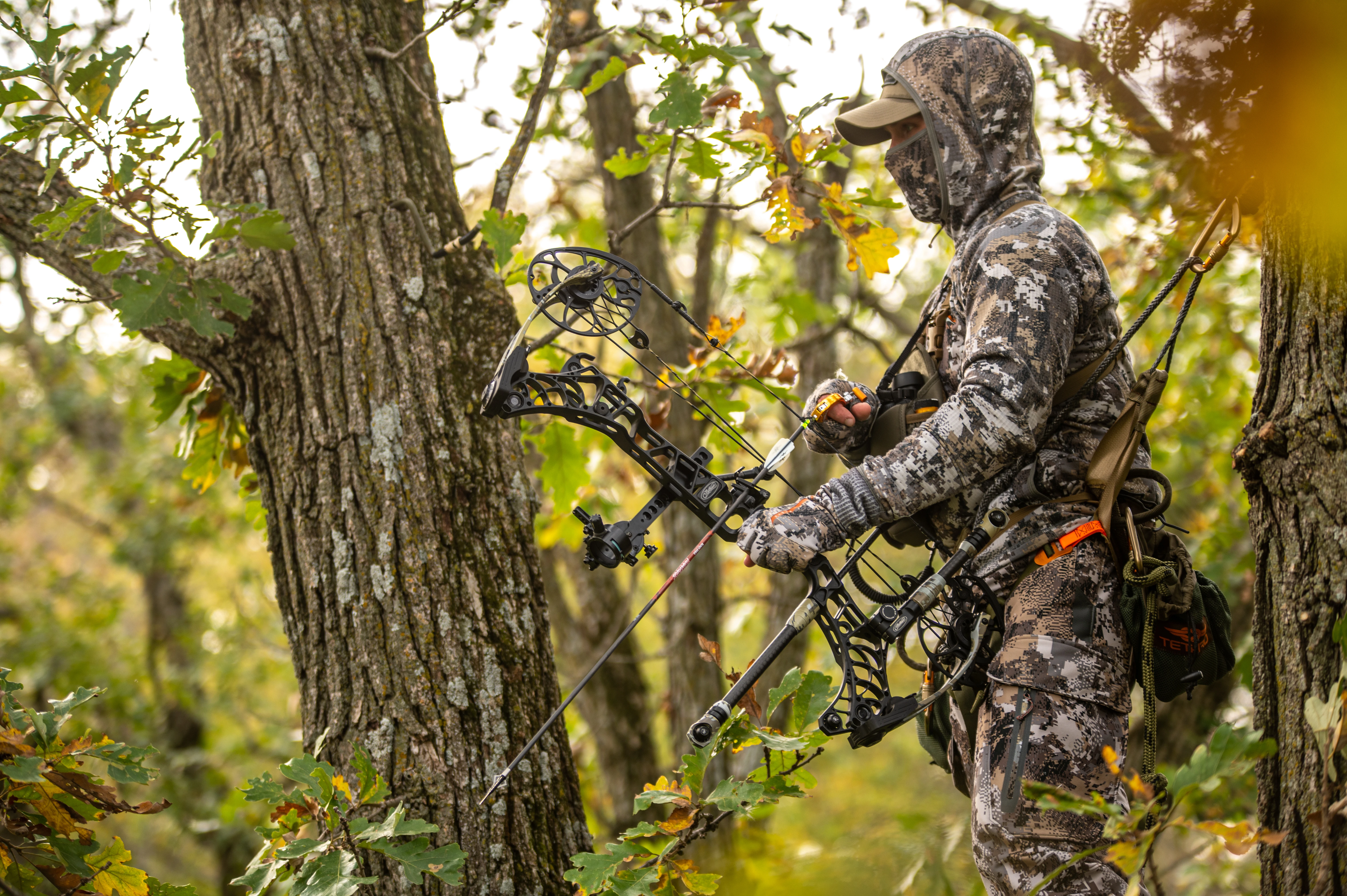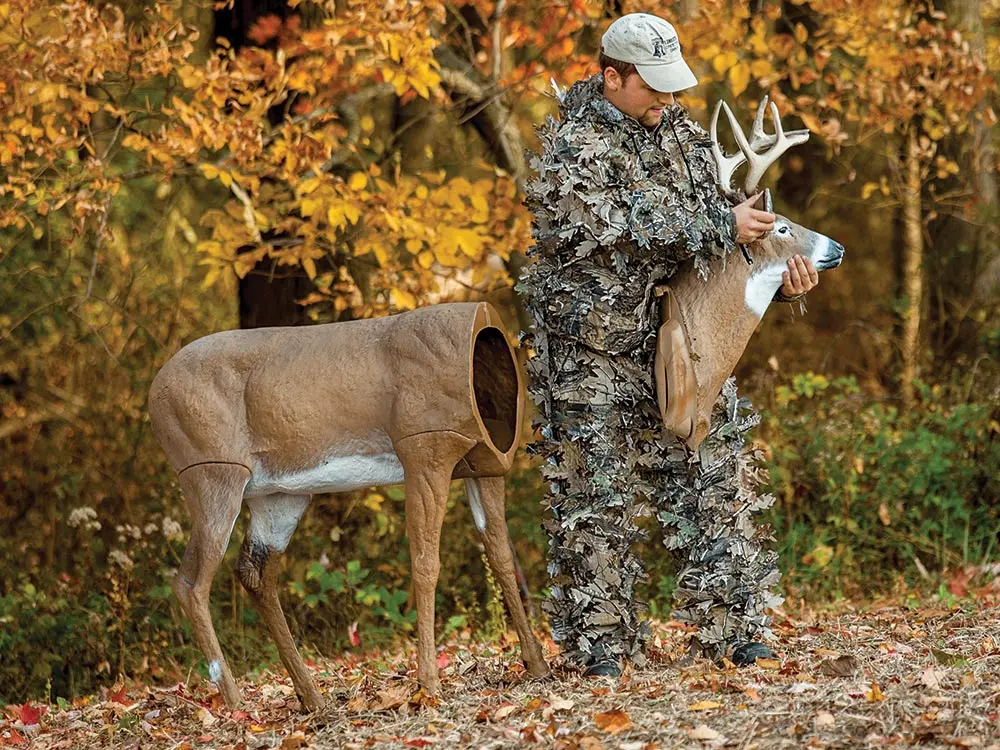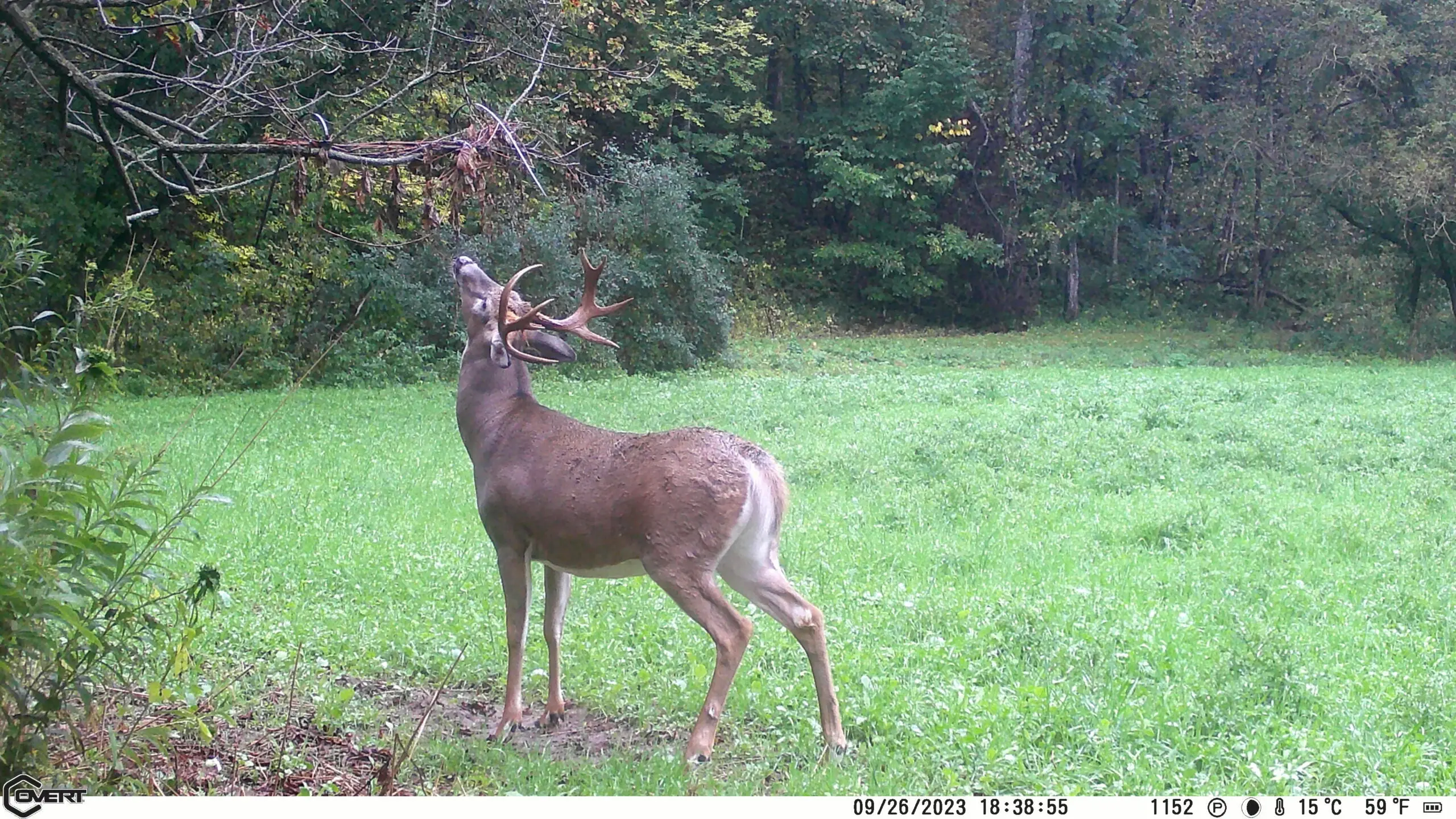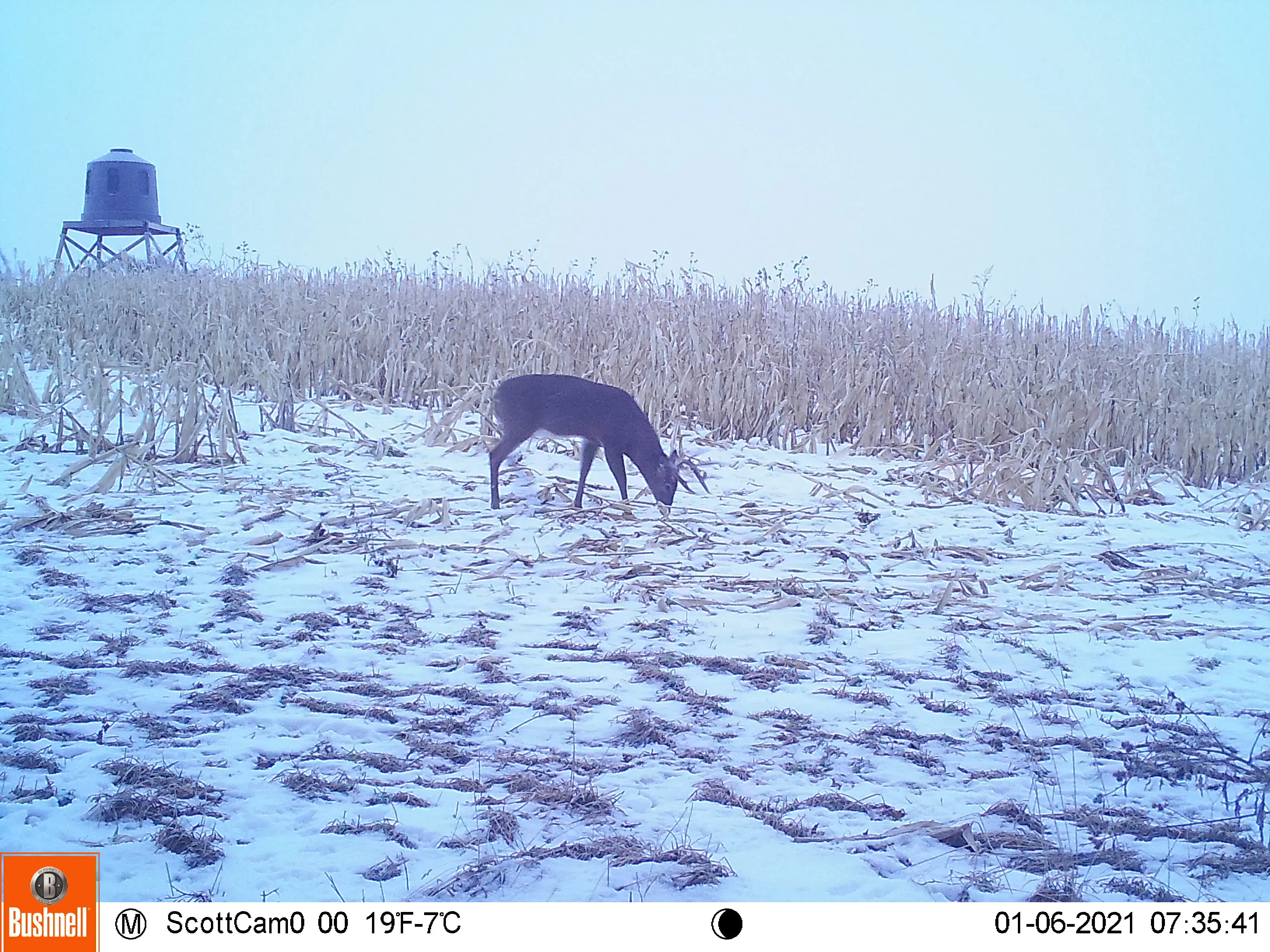One of the best things about the early season is that whitetails will waltz right into fields and food plots hours before last light in the evening. We get to see nice bucks dining in wide open spaces and take plenty of time to admire and judge and perhaps learn a little about them. But this is definitely a good-news-bad-news situation. The flip side is that when it comes to actually tagging one of these bucks, it can be highly frustrating, as those same bucks are often far out of bow range, and their favored entry points to the feed are frequently poor places to set up.
But take heart. With a little creativity, you can often turn an out-of-range field buck into a slam-dunk shot opportunity. Here are four ways to handle field-edge bucks.
1. Call Field Bucks Into Bow Range

My friend and F&S executive editor, Dave Hurteau, found himself a bit baffled by a bachelor group of bucks on his upstate New York lease a couple years ago. “These bucks would regularly feed in this clover field, and after observing them for several evenings, I not only knew exactly where they entered the field but I felt like getting a true wind that was favorable for me wasn’t going to be that hard,” he told me. “But when opening day came, I not only didn’t see any of the bucks, I didn’t see a deer. I returned for another sit or two and that pattern continued. I was getting a little frustrated.”
While it was tempting to think that the bucks had relocated, Hurteau's trail cams proved the bucks were still using the field. After thinking the situation over, the light bulb finally came on. “I realized my stand setup, while perfect for the wind, was close enough to the buck’s bedding area that one or more of them was spotting me every time I walked in,” he said. “While everything else about the setup was perfect, it was just too close to bedding to be effective. I decided to relocate to the opposite side of the field, where I could watch the entry trail and hopefully work one of the bucks to my setup with calling.”
His plan worked to perfection. As if on cue, the bucks started filing out onto the field at prime time. After giving them some time to feed, Hurteau grunted to get the attention of the group. “When the nicest buck snapped his head up and looked my way, I grunted at him, then snort-wheezed,” he said. “The first snort-wheeze got him moving my way a bit, so I gave him another and that was it; he trotted right over to see who the new buck in the neighborhood was, and I shot him at 25 yards.” And as if to prove it wasn't a fluke, he pulled the exact same trick again the following fall. Hurteau’s success proves that you can set up too close to a buck, and that even early-season whitetails are vulnerable to calling.
Related: The 7 Best Deer Calls of 2024
Dupe Field Bucks With a Deke

My friend Ted Marum had an early season buck on his Wisconsin farm that was a frequent visitor to a soybean field that was still mostly green. “He’s a nice buck, and he’s out in that field a lot,” Ted said when he invited me over for a hunt. “Trouble is, he’s bedding on the hillside above the beanfield and entering right by a washed-out gully in the corner of the field. I’ve tried hunting that spot enough to know it’s impossible to kill him–or any buck–there. The wind is just too swirly, and he’s going to nail you every time.”
But Marum had a solution before I even showed up to hunt. “I’m going to put you in a stand on the far end of the field, about 300 yards from where the buck comes out,” he said. “We’re going to set up a decoy facing where the buck enters and within bow range of the stand. That buck is going to come out and feed for a bit. The minute he takes a break, you hit him with a call. When he sees that buck decoy, I’ll bet he’s coming on a string.” I’d used dekes before, of course, but usually during the rut, when bucks are acting aggressive and vulnerable to such a tactic. Would a buck decoy work with the rut weeks away?
I didn’t have to wait long for an answer. While does and fawns kept me entertained for most of the evening, I kept my eye on the corner of the field for the buck. Right at prime time, he appeared at the woods edge, scanned the field for danger, then slipped into the beans for dinner. As soon as he lifted his head for a break, I grunted at him, to no effect; so I grabbed my rattling antlers, tickled them together, then looked at the buck. He’d snapped his head up, spotted the rival buck and was on his way in immediately. I arrowed him when he was nose-to-nose with the decoy. Ted’s lesson–that bucks are always sorting out dominance and working out aggression, regardless of season–has never left me. And you can put it to use yourself when you've got early season buck feeding in a large field.
Related: Best Deer Decoys
Set a Trap Line for Field Bucks

Calling, rattling, and decoys are definitely effective and often exciting, but they do come with a risk; they’re often a one-and-done, swing-for-the bleachers options. If you’re unable to close the deal with these tactics, chances are high your buck won't fall for those tricks again any time soon. But there's another way to lure a buck into bow range that's highly effective, but less dramatic.
Creating a line of mock scrapes along a field edge that starts at or near the buck’s entry and ends within range of your tree stand is a great tactic now. While many hunters think scrapes are just a rut thing, nothing could be further from the truth. Bucks (and does) visit scrapes year-round, and now that bucks are in hard antler, they’re experiencing the first serious testosterone dump in months, and scrapes are more attractive to bucks now than they’ve been in months. The great thing about a line of mock scrapes is that it’s super attractive to bucks, but a fairly non-intrusive tactic that doesn’t spook deer. Even better, creating the last scrape allows you to place it near a stand with adequate cover and the opportunity for a true wind direction.
Sit Smack in the Middle of the Field

The final option for dealing with a big field buck is to shun the edge of the field altgother and set up directly in it instead—especially in a section of field or plot where you’ve seen bucks feeding. In the early days of this technique, hunters would erect an elevated platform in the field, then set a pop-up hub-style blind on the platform. Having seen deer react to pop-up blinds before, I was initially skeptical about this approach, until I actually tried it. It’s definitely weird, but the same deer that will freak out when they see a hub-style blind on the ground will more or less ignore it if that same blind is only 6 to 8 feet off the ground. I’ll never forget the night when I watched four mature does and three borderline shooter bucks walk 15 yards from my blind and barely look at it—during a late season hunt, no less.
Of course, this technique has been improved in recent years, with companies offering hard-sided elevated blinds of a variety of materials, complete with generous windows, a weather-tight door, and a sturdy platform. Again, if you’re an old timer like me, the idea that you can sit in an elevated box out in the big wide open and a mature buck will feed within bow range during shooting hours seems absolutely bizarre. But it happens all the time and if you need proof just watch outdoor TV for a couple days. These blinds are so effective that it’s getting rare to see a TV hunter in a tree stand any more.
The down side to these blinds of course is cost, with even entry-level models costing a couple grand and the fancy models far outpacing that figure. But the original version of this set up—a pop-up blind on a homemade platform—still work just fine. Either way, these setups are deadly effective. One final thought about the placement of these units; focus on areas of the field where you’ve seen bucks feeding. Another solid technique is to “plant” a rubbing/scraping tree within range of the blind. (Cut down a small tree, dig a hole in the field, and erect it there.) Bucks in the field will gravitate toward this tree and walk within shooting range.
Related: Best Hunting Blinds of 2024


